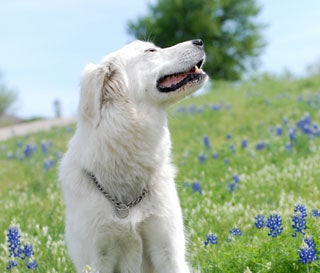Learn about dog breeds
Detailed information & photos on over 190 different breeds
Description
Great Pyrenees are a sheep dog that are well known for their abilities to keep sheep well guarded, protected and for their herding skills. The Great Pyrenees also can be a great protector to humans as well, which has led to them being used as watch dogs. The appearance of the Great Pyrenees is a tribute to their abilities.
Any gender of Great Pyrenees is huge with males being as large as 160 pounds or more. Other attributes of the Great Pyrenees are their superior eye sight and tall stance. They have thick fur that is always a light coloration. In the summer months they will shed their fuzzy undercoat in a fury of fluff. This and their enormous size make them less than ideal for indoor living. They much more prefer being outside where they can run and guard their family.
The Great Pyrenees can have some health concerns. They have double dewclaws which are usually reduced to one. Their metabolism is rather odd and a diet that is not specific can lead to health problems.
Coat Description
The coat of the Great Pyrenees is one of its stand out characteristics. The Great Pyrenees is known for the thick, woolly coat that offers protection to the dog. The fur is fluffy and quite repellent. It sheds often and this helps to keep the dog surprisingly clean.
History
The Great Pyrenees has always been bred as a work dog. They are an old breed that were bred as sheep dogs and every characteristic they display is a tribute to that fine breeding. They have been found in many places throughout the world, largely in Europe.
Temperament
The Great Pyrenees is bred to be smart and hard working. They are capable of being very independent. Their personality can only be described as purposeful. Every trait is something that is inherited through careful breeding.
They are often spunky and will not like to follow orders. Dominance on the owner’s part is a must to make this breed obey. However, the best approach is working together since this plays into their personality very well and is better accepted by them rather than being told what to do.
The Great Pyrenees herding instinct makes them good with children from the family. They will be protective and always keep a watchful eye on them. However, strange children may not get the warm welcome and the dog should be supervised around them. Children should be taught not to mess with the dogs ears and loud noises should be kept to a minimum for the greatest comfort for the dog.
The Great Pyrenees will show affection through leaning against someone or laying on them. If indoors when sleeping they are a cuddler of sorts and will be difficult to keep out of the bed. They are usually not aggressive and will only show aggressive behavior if not well trained and breed. Also too much controlling could lead to resistant behavior. Age also can bring about odd behaviors not seen before. They may be less tolerant of strangers and not as affectionate as they had been.
Health Problems
The only health problems usually seen in the Great Pyrenees are a result of their size. Breeding of this breed is usually done carefully and with purpose so genetic disorders are rare. The Great Pyrenees may experience problems like bloat, joint problems and deafness.
Grooming
The Great Pyrenees is bred to have a thick coat that will protect it during any weather conditions. The coat should never be shaved off. It will shed during the year which produces large amounts of fluff. The dog needs to be brushed often – one or more times per week. Due to the excessive shedding, this dog stays rather clean and will not require a lot of bathing. Gloves or other shedding tools can be used to help assist with the process and keep the coat looking good. The fur at the rear is often trimmed to prevent problems with debris tangles. The dewclaws should also be trimmed regularly. The Great Pyrenees also need regular ear cleaning which can be a challenge since they really oppose anyone touching their ears. It is something that should be done from early on to get them used to it.
Exercise
Since they are used to being able to roam about freely and constantly being on the go, the Great Pyrenees will be happy with a lot of exercise everyday. If left to their own doing they will usually run about happily all day. If taken away from home they should be kept on a strong leash or they may easily get away.
Training
Training the Great Pyrenees is a matter of relating with the dog. They prefer to be treated as an equal and will be more likely to go along with training if they are allowed to be involved in the process rather than being told what to do. They are very smart so trying to outsmart them will not work and could result in stubborn behavior.
Training is very important to develop a dog that listens and is well behaved. Their large size and independent streak can make training stressful, but it is all about the approach. With the right approach it should be rather simple for a Great Pyrenees to be trained.
Advertise | Privacy Policy | Terms of Use | Contact Us © Copyright 2004-2024 PupCity.com. All rights reserved.
